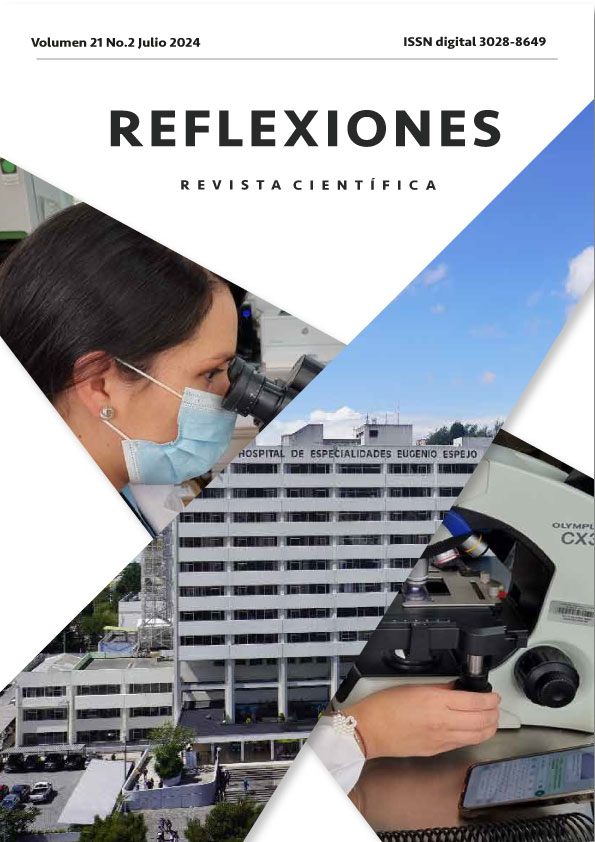GIANT UTERINE LEIOMYOMA A GREAT SURGICAL CHALLENGE, REGARDING A CASE
Abstract
Uterine fibroids, known as leiomyomas, are very common benign uterine tumors; they occur in 60% of women before the age of 40 and in 80% before the age of 50. There are several clinical and surgical therapeutic options being the hysterectomy the definitive and effective treatment.
We are presenting the clinical case of a 45-year-old patient of Afro-Ecuadorian ethnicity with a highly developed uterine fibroid that weighted 10,195 grams and occupied the entire abdominal cavity affecting her quality of life. The present case constitutes the first report of a benign giant uterine fibroid in the Gynecology service of Eugenio Espejo Hospital. Its surgical removal was challenging, however, taking precautions and trying to avoid complications we obtained favorable results after the intervention. There are few cases reported in the Ecuadorian literature up to date, being this case is the most important fibroid described.
References
2. Giuliani E, As-Sanie S, & Marsh E E. (2020). Epidemiology and management of uterine fibroids. International journal of gynaecology and obstetrics: the official organ of the International Federation of Gynaecology and Obstetrics, 149(1), 3–9. Disponible en: https://doi.org/10.1002/ijgo.13102
3. Management of Symptomatic Uterine Leiomyomas: ACOG Practice Bulletin, Number 228. (2021). Obstetrics and gynecology, 137(6), e100–e115. https://doi.org/10.1097/AOG.0000000000004401.
4. Salehi A M, Jenabi E, Farashi S, Aghababaei S & Salimi, Z. (2023). The environmental risk factors related to uterine leiomyoma: An umbrella review. Journal of gynecology obstetrics and human reproduction, 52(1), 102517. Disponible en: https://doi.org/10.1016/j.jogoh.2022.102517
5. Islam M S, Ciavattini A, Petraglia F, Castellucci M. & Ciarmela, P. (2018). Extracellular matrix in uterine leiomyoma pathogenesis: a potential target for future therapeutics. Human reproduction update, 24(1), 59–85. Disponible en: https://doi.org/10.1093/humupd/dmx032
6. Calaf J, Palacios S, Cristóbal I, et all..2020-03-27. Validación de la versión española del cuestionario Síntomas y Calidad de Vida en los Miomas Uterinos en mujeres con miomatosis uterina. Medicina. clín (Ed. impr.). 154(6):207-213. Disponible en: 10.1016/j.medcli.2019.05.027.
7. Merino Vaca RA. Manejo de miomatosis uterina. MetroCiencia [Internet]. 30 de junio de 2023; 31(2):92-95. Disponible en: https://doi.org/10.47464/MetroCiencia/vol31/2/2023/92-95
8. Jonas, H. S., & Masterson, B. J. (1977). Giant uterine tumors: case report and review of the literature. Obstetrics and gynecology, 50(1 Suppl), 2s–4s.
9. Pereira F, Arcia A. Fibromiomatosis uterina gigante: Reporte de caso. Rev Obstet Ginecol Venez. 2008 Sep; 68( 3 ): 206-210. Disponible en: http://ve.scielo.org/scielo.php?script=sci_arttext&pid=S0048-77322008000300012&lng=es
10. Lopez. N., Ferrufino G., Guardia. R., & Arce. L. (2020). Leiomioma celular gigante con degeneración roja, hidrópica y quística: reporte de un caso. Gaceta Médica Boliviana, 43(2), 215-218. Disponible en: http://www.scielo.org.bo/scielo.php?script=sci_arttext&pid=S1012-29662020000200015&lng=es&tlng=es
11. Mena L, Lizano G. Miomatosis Uterina Gigante 1-may-2016. Universidad Técnica de Ambato-Facultad de Ciencias de la Salud-Carrera Medicina. Disponible en:http://repositorio.uta.edu.ec/jspui/handle/123456789/23083
12. Unda M, Aldaz A, Bailón G. Mioma gigante de útero productor de poliglobulia. Reporte de un caso y revisión bibliográfica. 2010. Rev. ¨medicina¨. 15(3): 222-226.
13. Steward, R. G., Denhartog, H. W., & Katz, A. R. (2011). Giant uterine leiomyomata. Fertility and sterility, 95(3), Disponible en: https://doi.org/10.1016/j.fertnstert.2010.10.016
14. Babalola, O., Gebben, D., Tarver, M. E., Sangha, R., Roberts, J., & Price, V. (2023). Patient Preferences Regarding Surgical Treatment Methods for Symptomatic Uterine Fibroids. Therapeutic innovation & regulatory science, 57(5), 976–986. Disponible en: https://doi.org/10.1007/s43441-023-00525-1
Copyright (c) 2024 REFLECTIONS. Scientific journal of Eugenio Espejo Hospital

This work is licensed under a Creative Commons Attribution 4.0 International License.


